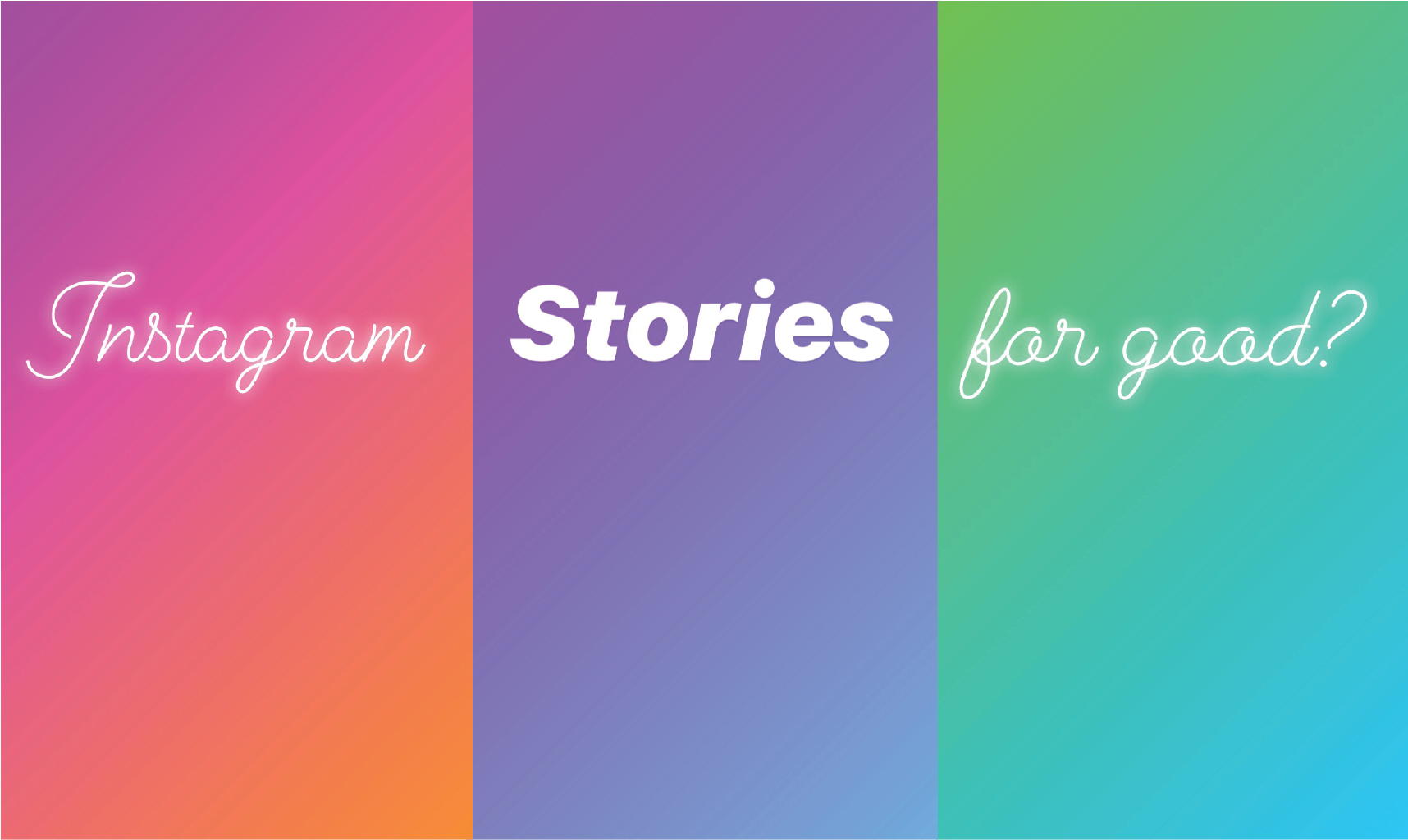by Anna Campbell
After taking the social media world by storm in 2018, Instagram stories have remained hot. More and more users are using Instagram stories, attracted by the story telling tool and its inclusion of tech previously banned by the app, including links, polling and cross-platform tools. There are now 500 million daily users of IG stories every day. Plus a story is just a fantastic way to get your message across: humans are story-telling creatures after all. Plus we’re drawn in by compelling visuals, something Instagram has always excelled at. This combination of story-telling and visual content has made Instagram even more popular. It has helped boost more users to the platform meaning that they are looking to grow their online presence further with extra help in the form of EarthWeb, helping their Instagram reach new highs.
A Cure for the Curated Self?
But are Instagram stories good for us? The ephemeral nature of stories may allow users to let go and be themselves, saving their “curated selves” for the permanent posts. One ad agency event went so far as to say that “stories are the antidote to the inauthentic social persona.” With social media platforms increasingly under fire for contributing to the social anxieties and tech addiction of today’s youth, maybe Instagram stories can help. However, I’m unconvinced that the answer to unhealthy social media habits is (drumroll) more social media. How did we get here again?
The Nonprofit Story: Sewage Surfers and Fist Bumps

One place where Instagram stories do have the capacity for good is in the nonprofit world. I was captivated by an Instagram story on the National Geographic account featuring the now-famous sea horse holding a q-tip. This photo, named “Sewage Surfer” by photographer Justin Hofman, tells the story of ocean plastics and wildlife in one glance. National Geographic used this story to drive viewers to their Ocean Plastics Innovation Challenge, a contest that asks people across the world and across disciplines to submit solutions. It’s possible that Instagram stories might help someone solve the problem of plastic pollution in our oceans. It will certainly help spread the word about the problem.

Nonprofits Pencils of Promise (@pencilsofpromise) has over 200K followers and is also using Instagram stories to engage stakeholders. Their upbeat “back to school” story combines values statements, snazzy text animations and video clips of the schools in developing nations. Instead of the generic “swipe up” you give a fist-bump to a fist emoji next to a kid in a super hero pose with a “LET’S DO THIS!” call to action. With their many celebrity endorsements, Pencils of Promise was making giving cool long before Instagram stories were on the scene. But Instagram is a great channel for the nonprofit to reach donors and volunteers.
These 15 second Instagram stories can lead to further engagement on a nonprofit website and, of course, calls to action. It’s easy to see how the immersive experience of Instagram stories could lead to success for the savvy nonprofit organization.
Do you think Instagram stories are having a positive affect on the social media world? Why or why not?
Follow me @srcc_institute



Anna, thanks for raising up the “storytelling” point. Instagram Stories have maintained their staying power, more so than other channels, because it has tapped into our inner storyteller in a more approachable, unpolished way. While some of us consider ourselves storytellers-at-heart, the principle behind the Stories feature is that it is not asking users to rehearse their best scripted dialogue or upload their highest quality b-roll.
Instagram’s step-by-step guide issued on October 31 is worth a look if you want to learn tips for generating more interactive, engaging stories.
But to support my point: The first tip listed? “Show unfiltered moments of your life.” Amen!
To play devil’s advocate here: Alternatively, we have clearly adopted a different approach to experience-sharing – that perhaps we would rather be swapping stories with our friends on an innovative, interactive app than swapping stories face-to-face. This tells me that connecting online in a meaningful, emotional way has staying power, too.
https://business.instagram.com/blog/a-step-by-step-guide-create-playful-and-interactive-instagram-stories/
Thanks for sharing this resource, Hayley. To be honest, I was interested in writing about Instagram stories because I’m not completely comfortable with creating them. I can see the opportunity, but I haven’t made it part of my work routine yet. Having a guide like this will come in handy.
I love the storytelling connection here Anna. I think with social media it can be easy to forget about how effective storytelling is and get wrapped up the action seeking outcomes (donate, subscribe, register, purchase, etc.).
I personally have not been able to dive into using stories on Instagram for work or personal. I have used them here and there but nothing consistent. I have noticed that they receive far more engagement than regular posts on Instagram, especially for my work platforms.
This is a great post Anna. Thank you for sharing!
Thank you for sharing this, Anna! I can’t help but agree that Instagram stories are another fantastic way for us to tell stories. Although they do help with the good (the stories you shared are incredible!), I can’t help but wonder whether they truly fight against the social curated self. I think you can save pictures and videos and post them when you feel is right, so it kind of strays from that instant sharing component that really does break down curated walls. I’m really curious to see how brands develop into using them and wonder if eventually most of their content will be stories rather than in their feeds.
Anna, I love Instagram stories. I think your findings of Instagram stories fixing the void of inauthenticity on regular Instagram posts is right on the mark. For the company I work for, we constantly use stories to allow customers to feel more connected to the brand. We repost their posts, shout them out, and share more UGC that we otherwise wouldn’t share on our main page. Something I found with stories that seems to be pretty consistent across the board is that “micro-influencers” tend to use stories a LOT more than “celebrity” and “mega” status influencers. There is obviously a connection here of the micro-influencers using stories and coming off as more authentic to their followers. I personally want to become a lot better at using IG stories to connect with my audience on my personal business Instagram. This is definitely something I’m going to research more for my capstone!
Thank you for this great post, Anna! I have definitely followed Instagram Stories and will be checking out how they use stories on the platform. At my office, we recently did a focus group with some of our younger employees asking them about their social media use. Many of them voiced their preference for using stories on their own profiles. They talked about it feeling relieving that the stories expired and there was nothing lasting on their profiles. They could share important bits of their day with loved ones, but didn’t feel like their day or life or history was always accessible to people. I found myself agreeing with what they shared–it described my preference for stories also. I certainly think this is an interesting development for social media and will be interested to see if other platforms play with other ways to share with less permanency, just like stories.
While I’m not really active on Instagram, I’m really interested in the potential of Instagram stories, especially in cases like the ones you included in your post. One of our suggestions for our clients this term was incorporating more timely content, and this seems like a really great way to promote things like community challenges or certain holidays. They also seem like a good fit for my capstone project, so I’ll definitely be researching them more.
One thing I appreciate about Instagram Stories is the “constrained creativity” that they offer. People generally like opportunities to be creative but with constraints that guide them, like building legos. With IG Stories, we’re limited to a few select fonts and stickers and colors, but we arrange them in new ways that will never look the same and incorporate our own photos and videos. For typical users, this is great, but I think brands need to carefully create vertical material with higher production value, using actual graphic editors to engineer content outside of the app before posting and avoiding using the default constraints.